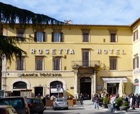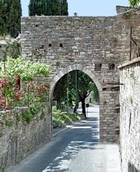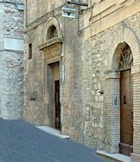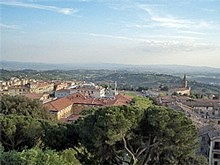
Rione di Porta Eburnea
Much of this area was destroyed in ca. 1540
to make way for Rocca Paolina (see below)
The church of Santa Giuliana is to the right in this photograph
Leave Piazza IV Novembre along Corso Vannucci and continue to Piazza della Repubblica (described in Walk I).
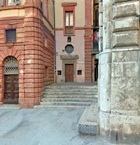
-
✴Palazzo Patrizi, which is now the Hotel Locanda della Posta, at number 89-101;
-
✴the Baroque Palazzo Montesperelli (17th century) at number 103-7; and
-
✴the important Donini palaces opposite, with the church of Santa Maria del Riscatto on the narrow site between them (illustrated here).

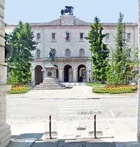
The next part of the walk is slightly complicated because it explores the area at three different times:
-
✴before the construction of Rocca Paolina;
-
✴after its construction, which involved the destruction of some 200 houses, ten or more churches, a college and two nunneries; and
-
✴after its demolition in 1860, when the area was redeveloped.
Before Rocca Paolina
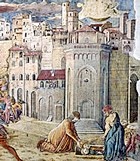
Follow the original line of Via dei Sellari to the statue of King Vittorio Emanuele II (below) that now stands at the centre of Piazza d’ Italia. Two buildings here were demolished to make way for the fortress:
-
✴the ancient church of San Silvestro, which was believed to have stood on the site of the house of St Herculanus; and
-
✴the Albergo di San Marco, which stood on the opposite side of the road.
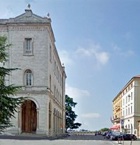
-
✴Santa Maria dei Servi, which stood on what is now the site of Hotel Brufani (the ochre building on the right, described below), with its apse against the Etruscan city wall; and
-
✴the college known as the Sapienza Nuova.
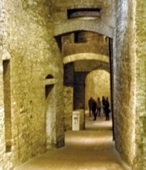
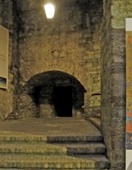
Walk along the loggia of the palace and take the escalator down. This leads to the site of a road junction in the Baglioni quarter, which was of course, originally open to the sky:
-
✴the excavated Via Bagliona to the left passed a number of Baglioni palaces and continued to Porta Marzia (below)
-
✴the unexcavated road to the right led past the ancient parish church of San Paolo to Piazza Santa Maria dei Servi.
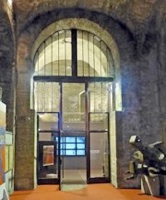
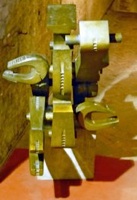
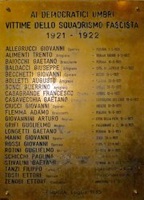
Turn left along Via Bagliona. The door in the opening immediately on the left leads to space used by the Centro Espositivo della Rocca Paolina (CERP) for exhibitions. The monument (1984) to the right of the door, which is by Romeo Mancini, commemorates 22 Perugian victims of the Fascist executions of 1921-2: the list to the right of the sculpture records their names and gives for each of them the place and date of the execution.
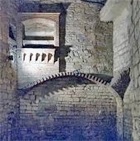
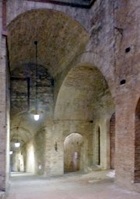
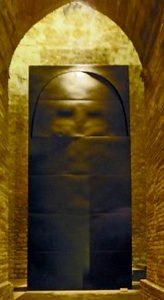
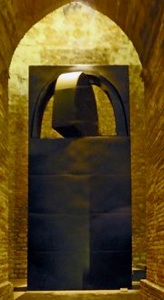
The huge statue (1980) of "Il Grande Nero" in the next opening to the right is by Alberto Burri, who gave it to the city in 1984. The upper, semi-circular section rotates very slowly, so that the woman’s face on it is rarely visible.
The escalator beyond this point, which was opened in 1983, leads along the line of the old fortified corridor from the fortress to the southern stronghold (described below) to what is now Piazza dei Partigiani (below).
Return to and continue along Via Bagliona to the Trivio (junction): before the fortress was built, Via dei Sellari (above) continued to this point, following a line across what is now is now Piazza d’ Italia. Take a short detour by turning left along the excavated stretch of it, past the remains of:
-
✴the palace of Braccio and Ridolfo Baglioni on the left (illustrated here); and
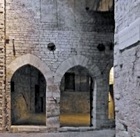
-
✴that of Gentile Baglioni on the right.
Continue to the point at which the the excavation of Via dei Sellari ended. The road to your right just before this point led to the upper church of Sant’ Ercolano (described in Walk IV).
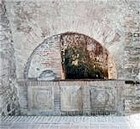
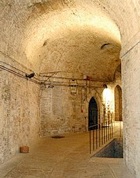

Rocca Paolina
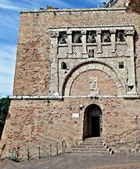

Look back as you leave the complex at the remains of the curtain wall of Rocca Paolina. The components of the upper part of Porta Marzia were fortunately preserved and incorporated into this wall. The arms of Pope Paul III and the inscription “PP III” that were inserted below them were subsequently defaced, probably in 1798.
The next part of the walk follows the perimeter of the fortress. Very little of the original structure survives, but it is recorded in the series of paintings (19th century) by Giuseppe Rossi reproduced below. These paintings, which are now in the Galleria Nazionale, show the complex after the moat was filled (in ca. 1800) but before a large part of the fortress itself was demolished (in ca. 1860).
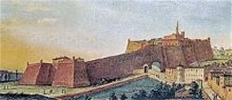
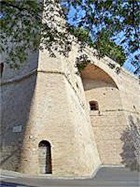
View of the fortress, the southern stronghold Original point of departure
and connecting corridor, from the east of the corridor
Continue down hill along Via Marzia, with the remains of the fortress wall on your right. As described in more detail in Walk II, this road was built in 1810, after the moat here had been filled in. Continue to the junction with Viale Indipendenza. The spur in the wall at this junction (illustrated above) marks the point at which the fortified corridor linking the main part of the fortress to the southern stronghold began.
All trace of the corridor and southern stronghold was destroyed after 1860, but they are recorded in the first two paintings by Giuseppe Rossi reproduced here (one above and one below). From 1543 until 1831, this corridor completely separated Borgo Porta Eburnea on the left from Borgo Porta San Pietro on the right. In 1831, an arch was opened in it so that the road to your right (now part of Viale Indipendenza) could be built. This arch can be seen in the first of the paintings by Giuseppe Rossi (reproduced above).

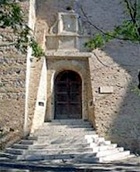
View of the corridor and Porta del Rastello Porta del Soccorso
Turn right along Viale Indipendenza, with the remains of the wall of the main part of the fortress still on your right, to Porta del Soccorso, an emergency exit from the main part of the fortress. Again, the papal insignia has been destroyed. This second painting by Giuseppe Rossi (above) shows the view towards this point from the south west. A gate known as Porta del Rastello to the left of the corridor was in line with Porta del Soccorso behind.
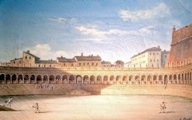
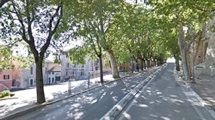
The curtain wall beyond Porta del Soccorso does not survive, but it can be seen on the right in this third painting by Giuseppe Rossi. The painting also shows the stadium in front of it, which Cardinal Agostino Rivarola built century beside the fortified corridor in 1805-8 as part of a series of modifications designed to make Rocca Paolina more acceptable to the Perugians. This stadium was used for “gioco del pallone”, a ball game then much in vogue, and for other spectacles, including bull fights. Part of this structure stood in what is now Via del Circo, below and to the left of Viale Indipendenza (to the left in this photograph, in which Porta del Soccorso is visible at the extreme right).
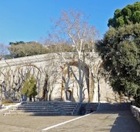

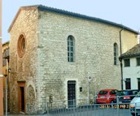
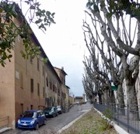
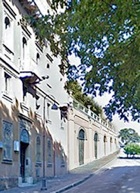

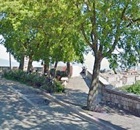
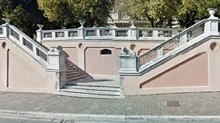
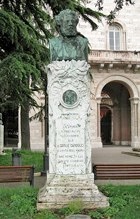
Continue round Palazzo della Provincia and look back on its main façade from Piazza d’ Italia.
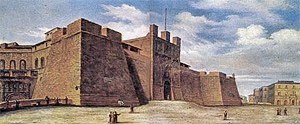
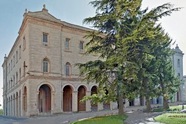
This fifth painting by Giuseppe Rossi shows the area after Cardinal Rivarola filled in the moat on front of the fortress to establish an elliptical space that was then called Piazza Rivarola. The main façade of Palazzo Ansidei (above) can be seen to the right.
After Rocca Paolina
Marchese Gioacchino Napoleone Pepoli, who served as the Commissario Generale Straordinario delle Provincie dell’ Umbria after the liberation of Perugia in 1860, signed a decree (15th October) that gave the Rocca Paolina to the city. The city authorities duly authorised its demolition on 17th December.
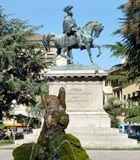
Alessandro Arienti, who was appointed as the chief engineer of Perugia in 1865, prepared the redevelopment plan for the entire area over the period 1866-83. The construction of the Palazzo della Provincia (1869-72) was at the heart of it.
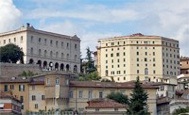

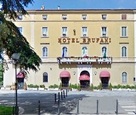
Palazzo Calderini (from behind, Palazzo Cesaroni Hotel Brufani
with Palazzo della Provincia to the left)
Proceeding anti-clockwise, the other important buildings established here at around this time include:
-
✴the semi-circular Palazzo Calderini (1871), to the left of Palazzo della Provincia, which followed the curve of the elliptical piazza;
-
✴Palazzo Cesaroni (1897), which was built in line with Palazzo Donini (above) on the side of the piazza opposite Palazzo della Provincia; and
-
✴two structures that were built on the terrace established along the right side of Palazzo della Provincia , replacing Via dell’ Alberata (mentioned above):
-
•the Banca d’ Italia (1871), designed by Guglielmo Rossi; and
-
•Hotel Brufani (1881), designed by Alessandro Arienti for Giacomo Brufani when his original hotel (later Palazzo Gnoni-Mavarelli - see below) proved to be inadequate.
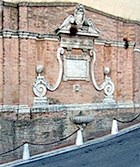
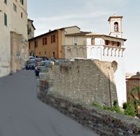
The inscription on the fountain also explains that the earlier road here was “too narrow, too sharp in its descent and too tortuous”, so Cardinal Lomellini made it “wider, gentler in its descent, straighter and more noble ... for the convenience of the citizens who, as a sign of their gratitude, call it Via Lomellina”. This new road might have had a gentler slope than its predecessor, but it nevertheless descended steeply, in a straight line continuing that of the ochre buildings behind you (seen in the photograph above). In 1830, after the moat of Rocca Paolina had been filled in, the present Via Marzia replaced it, secured by the retaining wall on the left: this new road curved to the right, allowing a gentler descent.
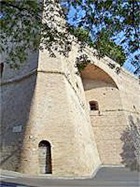
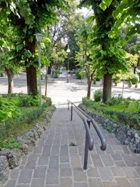
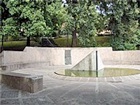
-
✴The back of Palazzo Gnoni-Mavarelli is on your left. (You can usually enter through a door here to see the front of the palace).
-
✴The back of what was the Caserma dei Carbinieri (1890), is in front of you: it now the Umbrian headquarters of Radiotelevisione Italiana.

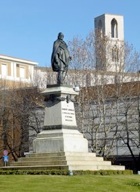
Continue round the curve of the road into the bus station in what is now Piazza Partignani. This area, which was levelled after the demolition of the southern stronghold, was known as the Piazza d’ Armi and served as a huge parade ground and weekly livestock market. In 1911, two early aeroplanes managed to take off from here and land in Foligno. During the Second World War, the space was cultivated to provide food for the city. This piazza, which received its current name after the war in honour of the anti-fascist partisans of Perugia, is connected to Piazza d’ Italia by the escalator from the excavated area under Palazzo della Provincia (above).
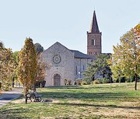
Porta Eburnea
Return to the bus station, take the steps to the left up to Via Masi and continue uphill. Turn turn left long Via del Parione (signed to Santo Spirito - see below). This street runs between the walls of two old prisons: the Istituto di Pena Femminile (women’s prison) on the right; and the Istituto di Pena Maschile (men’s prison) on the left:
-
✴This photograph shows the view along Via Torcoletti from its junction on the right of Via del Parione. The entrance to the women’s prison is on the left of it.
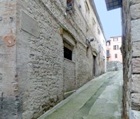
-
✴This photograph shows the view back along Via del Parione, with the back wall of women’s prison on the left (in Via del Giardino - see below) and the men’s prison on the right.
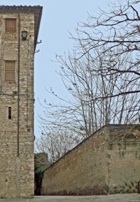
These prisons were built in ca. 1870 to take both criminals (who had previously been incarcerated in Palazzo dei Priori) and political prisoners (who had previously been held in Rocca Paolina).
-
✴The last execution by decapitation in Italy took place outside the men’s prison in 1874.
-
✴The women’s prison was notorious in the Fascist period. The inscription on its back wall (cut off at the left in the photograph above) commemorates the female victims of the Tribunale Speciale who were imprisoned here during the Fascist government.
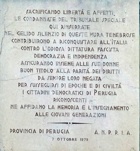
The prisons remained in use until the late 20th century, when the prisoners were moved to the Carcere di Capanne.
The monuments that were demolished to make way for these prisons included:
-
✴two nunneries:
-
•the Monastero delle Bartolelle; and
-
✴the church of San Nicolò, which had subsequently been re-dedicated as San Giorgio dei Tessitori.

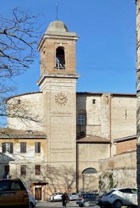
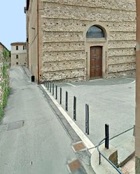
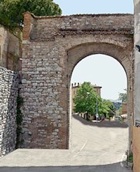
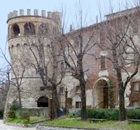
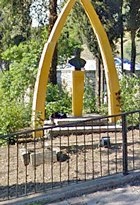
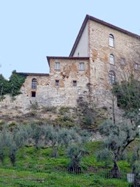
A short detour to San Prospero starts here.
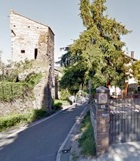
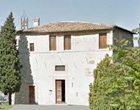
Return to the Istituto Don Bosco, where the detour ends.
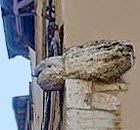
-
✴Via Paradiso on the left;
-
✴Via San Giacomo ahead;
-
✴Via Eburnea (which leads to Porta Eburnea - see above) on the right; and
-
✴Via degli Apostoli to the right of Via Eburnea, which seems to have been named for the Monastero degli Apostoli. The “Apostoli” were a community of lay penitents (also known as Fraticelli) who built a small monastery on land in this area that was donated to them in 1391. The complex was documented again in 1528, when the Commune gave it to the nuns of Sant’ Antonio da Padova. Nothing else is known about it, but the name of the street suggests that it was close by.
A large fish (very damaged) carved in the round has been inserted in the wall at the right-hand corner of Via Eburnea and Via San Giacomo.
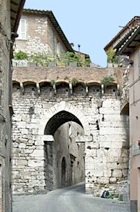
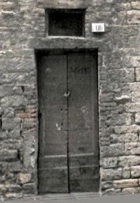
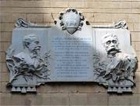
-
✴the artist Domenico Bruschi (1840-1910); and
-
✴his father Carlo Bruschi, who was a prominent statesman during the liberation of Perugia from papal control in 1859-60.
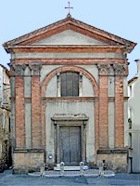

Return to Via Cesare Caporali. An Etruscan well (3rd century BC) that was discovered here cannot be visited. Its construction is apparently similar to the more famous Pozzo Etrusco in Piazza Danti, and it is interesting to note that both were sunk just inside the walls of the Etruscan city.
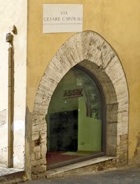
Turn left along Via Bonazzi, passing on the right the steps of Via Grecchi on the right. This street is named for Mario Grecchi, who was severely wounded near Perugia in 1944, when he was still only 18, while leading a company of partisans against a German battalion. He was severely wounded but kept alive long enough to face death by firing squad.
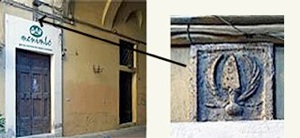
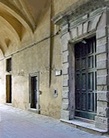
ex-Oratorio dei Santi Crispino e Crispiniano ex-Chiesa del Suffragio
There are two interesting buildings on the left:
-
✴the ex-Oratorio dei Santi Crispino e Crispiniano at number 41; and
-
✴the ex-Chiesa del Suffragio at number 37.
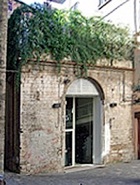
Via Larga is ahead on the left. In 1785, Ugiccione di Sorbello gave his palace here [which building?] to the Eugeni family in 1785 in exchange for Palazzo Sorbello.
Continue to the end of Via Bonazzi into Piazza della Repubblica and return along Corso Vannucci into Piazza IV Novembre, where the walk ends.




